
Stacer: Linux Systems Monitoring and Optimization Software
According to its own creators, «Stacer» is an open source system optimizer software and application monitor which helps users to manage the whole system with different aspects, it is an all-in-one system utility.
In more detail, we could describe this application like a capable of allowing us to view the characteristics of our computer, make a «mantenimiento» and therefore, a «optimización» of our Distro or Linux Operating System, in addition to «monitorizar» (organize and verify) services and programs that run on it, reaching even power uninstall packages in case we tell you.
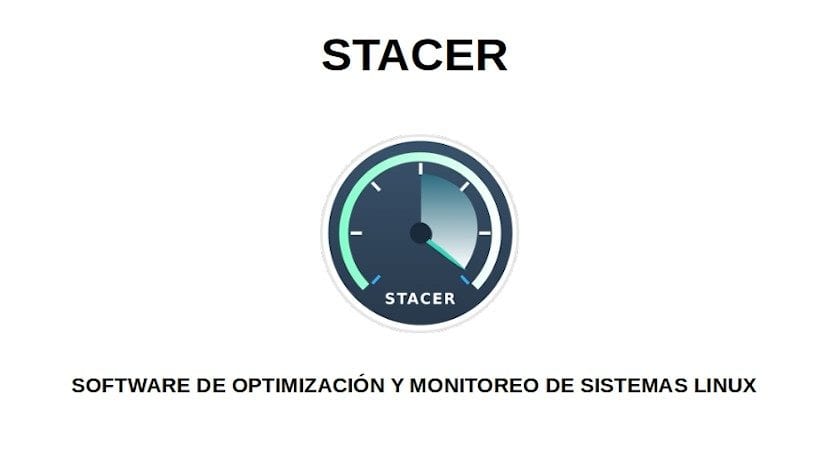
As in others publications (articles) we have referred to Stacer o talked in depth about Stacer, in this post we will go straight to the point, about the features and installation of its current version.
What does Stacer bring back
Sections

Instrument Panel (Desktop)
«Stacer», it has several sections or tabs to group its functionalities. But, on the first screen when starting it shows the section called «Panel de Instrumentos o Escritorio (Dashboard, en inglés)». In it, the application shows us an interface that allows us to view the current status of the main elements of the Distro or Linux Operating System, such as:
- Percentage (%) of CPU used.
- Percentage (%) of RAM memory used.
- Percentage (%) of Disk or Root Partition (/) consumed.
- Network traffic in bytes, upload and download obtained in real time.
- Summary of System Information (Computer): Both Hardware and Software.
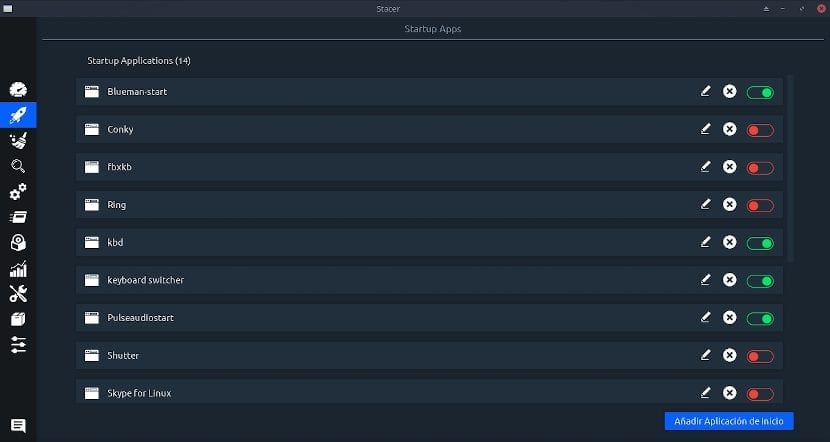
Startup apps
In the next tab corresponding to «Aplicaciones de inicio (Startup Apps, en inglés)», they can see which applications in the operating system are starting at startup and configure new applications to be loaded during startup.
This functionality is very useful, to avoid that average users need deep or advanced knowledge, about where and how the applications that run at boot time should be configured in each different Distro or Linux Operating System. Or on the contrary, how you can lock (remove) an application to prevent it from starting during the next startup. That is, it facilitates and allows the management of all this related activity.
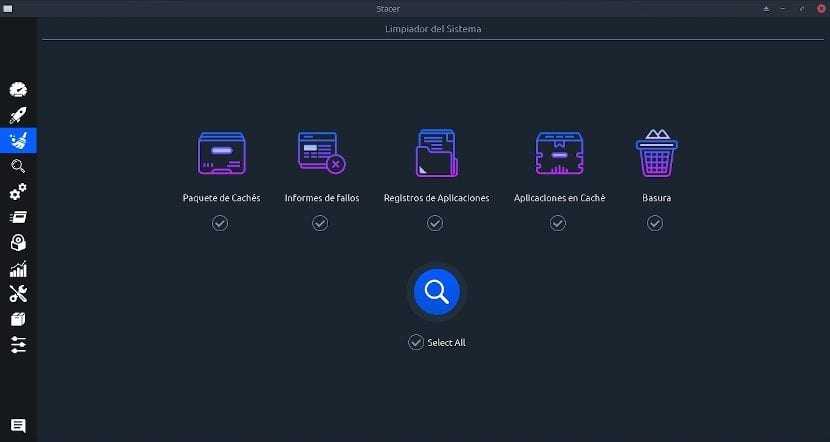
System Cleaner
In the next tab corresponding to «Limpiador del Sistema (System Cleaner, en inglés)», can be selected various items that the application is capable of scanning and then cleaning, in case of having detected predefined elements subject to deletion for a efficient and effective cleaning of the system. The included items can be clearly seen in the image immediately above.
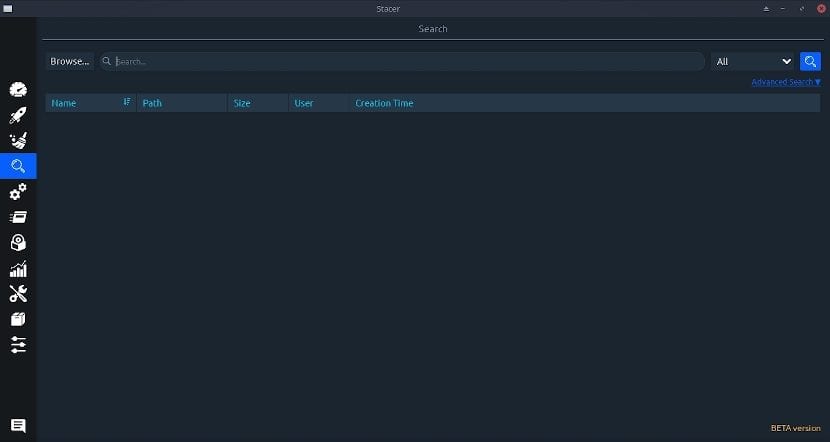
Search
In the next tab corresponding to «Búsqueda (Search, en inglés)», can be performed individual or collective searches of elements (files, folders, symbolic links) using alphanumeric character patterns, for later opening (viewing), erasure or elimination.
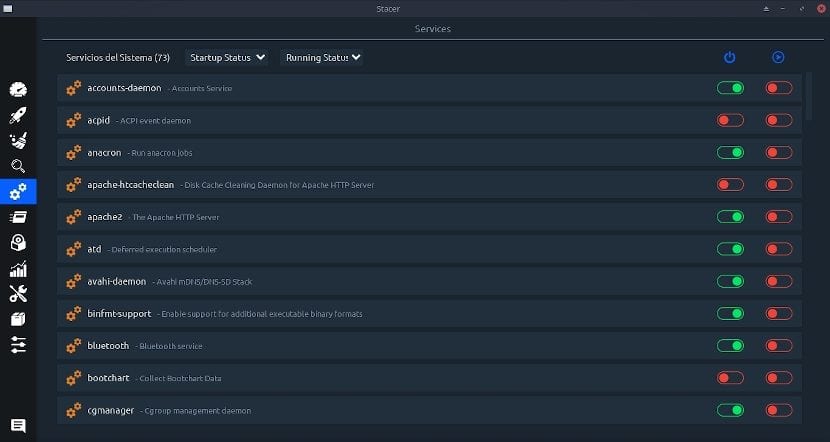
Services
In the next tab corresponding to «Servicios (Services, en inglés)», they can view and filter the different existing system services for subsequent enable or disable it. Filtering can be by boot status (enabled / disabled) or by running status (running / stopped).

Processes
In the next tab corresponding to «Procesos (Processes, en inglés)», they can visualize the main processes or all if necessary. You can locate one or more by searching for patterns of alphanumeric characters for their subsequent deletion with the button «Proceso Final».
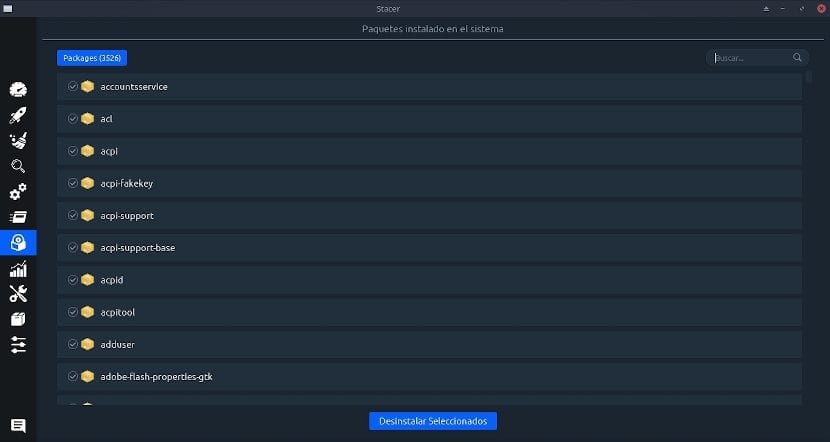
Packages installed on the system (Uninstaller)
In the next tab corresponding to «Paquetes instalados en el sistema o Desinstalador (Uninstaller, en inglés)», they can view all installed packages, and you can locate some or some by means of searches by alphanumeric character patterns for later elimination with the button «Desinstalar los seleccionados (Uninstall Selected, en inglés)».

Ressources
In the next tab corresponding to «Recursos (Resources, en inglés)», they can view the different hardware resources (CPU, Memory, Disk and Network Interfaces) of the computer, in the same way as any other Linux Resource Monitor application.
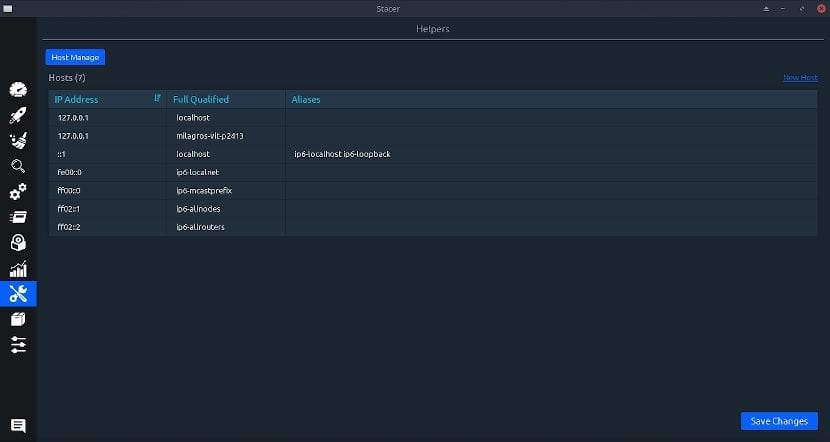
Helpers
In the next tab corresponding to «Ayudantes (Helpers, en inglés)», you can manage the content of the file «hosts» that is usually found on the route «/etc».
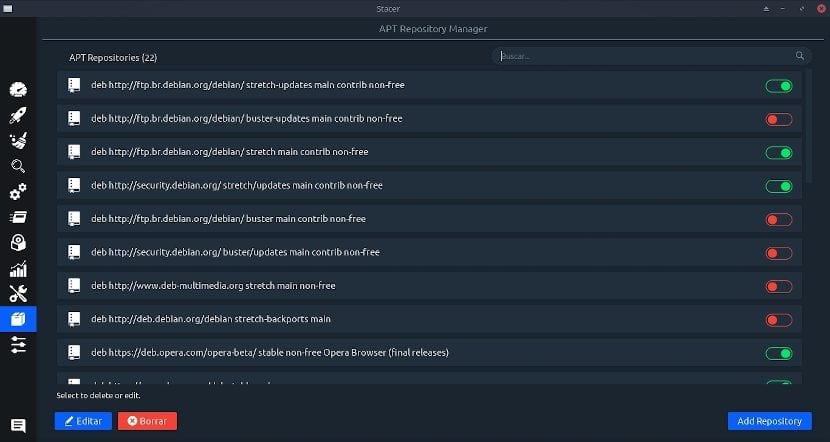
APT Repository Manager
In the next tab corresponding to «Administrador de Repositorios APT (APT Repository Manager, en inglés)», you can manage (add, edit and delete) the content of the file «sources.list» and other files «list» that are usually found on the route «/etc/apt» y «/etc/apt/sources.list.d/».
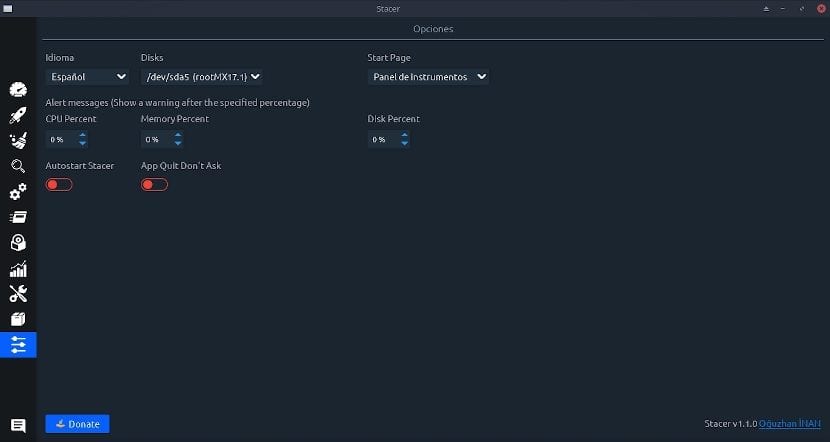
Options
In the next tab corresponding to «Opciones (Options, en inglés)», can be performed changes to the application settings, such as the language of the graphical interface, the main partition to be monitored, the application start page (tab), consumption alerts, among other settings.

Feedback
In the next tab corresponding to «Retroalimentación (Feedback, en inglés)», you can send a message or statement (feedback) to the creators of the application for among other reasons to improve its development, through suggestions, observations, criticisms or bug reports.
Download
Stacer is currently on the stable version 1.1.0which was released 08/06/19, and it can be downloaded through your official website Stacer, or your website at GitHub y Sourceforge.
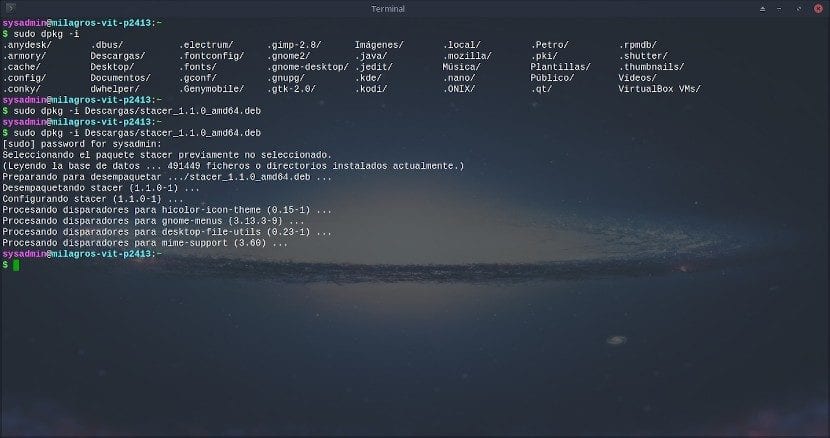
Installation
The various ways to install this practical application are:
Manual installation using GIT
git clone https://github.com/oguzhaninan/Stacer.git
cd Stacer
npm install
npm startDirect installation using the PPA Repository on Ubuntu
Execute command commands:
sudo add-apt-repository ppa:oguzhaninan/stacer -y
sudo apt-get update
sudo apt-get install stacer -yDirect download of .deb package for Debian x86
Download package from the web:
stacer_1.1.0_i386.debExecute command command:
sudo dpkg -i stacer*.debDirect download of .deb package for Debian x64
Download package from the web:
stacer_1.1.0_amd64.debExecute command command:
sudo dpkg -i stacer*.debDirect download of .rpm package for Fedora
Download package from the web:
paquete stacer_1.1.0_amd64.rpmExecute command command:
sudo rpm --install stacer*.rpm --nodeps --forceDirect installation using the DNF package manager in Fedora
Execute command command:
sudo dnf install stacerBuilding the package from source code using CMake (Qt 5.x)
Execute command commands:
mkdir build && cd build
cmake -DCMAKE_BUILD_TYPE=Release -DCMAKE_PREFIX_PATH=/qt/path/bin ..
make -j $(nproc)
output /bin/stacer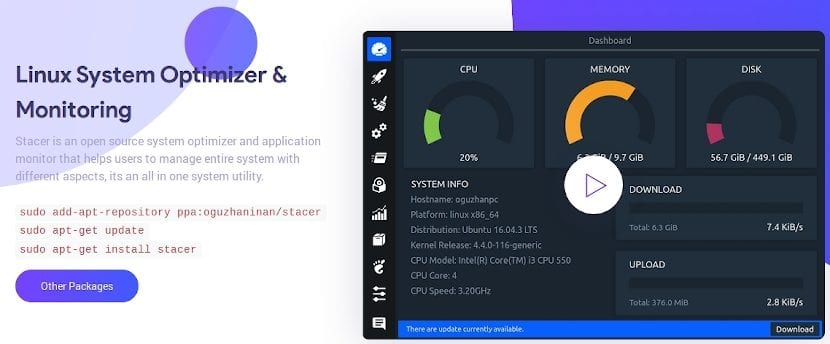
Conclusion
How we have been able to see and analyze, «Stacer» It is a program that fulfills two functions very well, on the one hand it allows us know absolutely everything related to performance of our respective Computers and Operating Systems, and on the other hand, it allows us run optimization tasks about the system. And this is truly its strong point.
From «Stacer» we can optimize what is necessary, either by cleaning all temporary files, removing applications or disabling unnecessary services, among many other small but useful functions. Which makes it a very intuitive application, since its menus have a very simple operation and an interface that is easy to understand and handle, even for users with little experience in these tasks on «GNU/Linux».
A very complete article about Stacer that, as you have shown, has plenty of arguments to be installed and used.
I will be a weird user, it will be because I am not reinstalling the system every new version or installing and uninstalling apps all the time, I just use my Linux Mint with the apps for my day to day, period. For this reason, I imagine, that it will be that I have not noticed a performance decrease that deserves to be noted, it is boring to the fullest in that sense GNU / Linux at least in my experience (also considering that my distro is derived from an LTS ), for all this is that I have not considered this type of application, but since it cannot be said, "I will never drink this water" it is always good to know it (and for this your article is perfect) in case it is ever necessary for me Its use.
Thanks Linux Post Install
That is the Arazal idea. Know! So that when we need X Apps we know what to look for. Otherwise, you are quite right, it is rare to do some maintenance and optimization on our GNU / Linux systems, since in general, as they come and are used, they last very well like this, almost their entire life cycle.
for my laptop with low RAM it should be fine to monitor and kill unnecessary apps that occupy ram, I will take a look
thanks for posting
Greetings, Srosuna! You are welcome providing knowledge for everyone!
I have installed Stacer, but the repository does not seem to have the proper signatures and says: The repository "http://ppa.launchpad.net/oguzhaninan/stacer/ubuntu focal Release" does not have a release file "Release".
Sorry, I have sent without wanting half of the message. Continuous:
N: You cannot update from a repository like this safely and therefore it is disabled by default.
N: Look at the apt-secure (8) man page for details on creating repositories and configuring users.
What's wrong with Stacer?
Greetings, Joan. Thank you for your comment, and regarding it I comment:
If you are going to install it from the ppa, check what repository version name you are placing, for example, it comes out like this:
"/Etc/apt/sources.list.d/oguzhaninan-ubuntu-stacer-hirsute.list"
And I edit the content and change "hirsute" to "disco", or "cosmic", or "bionic" or "xenial".
After that, if the repository key "0F6444BB6902FCAF" is not installed
Execute the following command prompt:
sudo apt-key adv –keyserver hkps: //keyserver.ubuntu.com: 443 –receive-keys 0F6444BB6902FCAF
Then:
sudo apt update
sudo apt install stacer
Anything, you can download and install it using the .deb or .appimage installers located here:
https://github.com/oguzhaninan/Stacer/releases/tag/v1.1.0